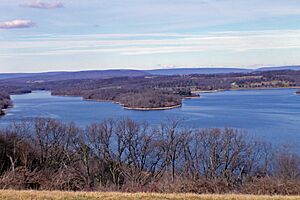Blue Marsh Lake facts for kids
Blue Marsh Lake is a large, man-made lake located northwest of Reading, Pennsylvania. It's managed by the U.S. Army Corps of Engineers, which is a part of the U.S. Army that helps build and manage public works projects. The lake is in western Berks County and gets its water from the Tulpehocken Creek.
The main part of Blue Marsh Lake is found along the border of Bern and Lower Heidelberg Townships. Some parts also reach into North Heidelberg and Penn Townships. In the middle of the lake, there's a big island where no one lives. Blue Marsh Lake is a very popular place, especially in the summer. People love to go there for fishing, swimming, and boating. The area around the lake has 36 miles of trails for hiking and exploring, and the lake itself covers 1,147 acres of water.
History of Blue Marsh Lake
Before the lake was built, there was a village called Blue Marsh in the same area. Locals often called this beautiful spot "Pleasant Valley." It was one of the first settlements in Lower Heidelberg Township. The land was very good for farming, and the area had many trees and lots of wildlife. There were many farms and old homes from the 1700s and 1800s. The village also had a church, a schoolhouse, a post office, and a general store.
When the lake was planned, some buildings were saved. For example, the Gruber Wagon Works, which was originally in a nearby village, was moved to a safe place before the dam was built. Parts of the Old Dry Road Farm were also moved out of the village. The people living in Blue Marsh village had to move because the government used something called "eminent domain." This means the government can buy private land for public use, even if the owners don't want to sell.
The idea for the lake started with the Flood Control Act of 1962. This law helped begin several projects in the Delaware River basin to control flooding. Later, in 1969, a Pennsylvania law provided money and permission to buy the land for the lake. The United States Army Corps of Engineers began building the lake in March 1974. They started by blocking the Tulpehocken Creek. The entire project was finished in September 1979, creating the Blue Marsh Lake we know today.


